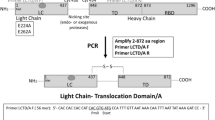Abstract
Botulinum neurotoxin (NT) serotype B, produced by Clostridium botulinum (proteolytic strain), is a ∼150-kDa single-chain polypeptide of 1291 amino acids, of which 10 are Cys residues [Whelan et al. (1992), Appl. Environ. Microbiol. 58, 2345–2354] The posttranslational modifications of the gene product were found to consist of excision of only the initiating Met residue, limited proteolysis (nicking) of the 1290-residue-long protein between Lys 440 and Ala 441, and formation of at least one disulflde bridge. The dichain (nicked) protein, in a mixture with the precursor single-chain (unnicked) molecules, was found to have a ∼50-kDa light chain (Pro 1 through Lys 440) and a ∼100-kDa heavy chain (Ala 441 through Glu 1290). The limited in vivo nicking of the single-chain NT to the dichain form, by protease endogenous to the bacteria, and the nonfacile in vitro cleavage by trypsin of the Lys 440–Ala 441 bond appear to be due to the adjacent Ala 441–Pro 442 imide bond's probable cis configuration in a mixed population of molecules with cis and trans configurations. The two chains were found connected by an interchain disulfide formed by Cys 436 and Cys 445. Six other Cys residues, at positions 70, 195, 308, 777, 954, and 1277, were found in sulfhydryl form. In addition, a Cys at position 1220 or 1257 appeared to be in sulfhydryl form, hence our experimental results could not unambiguously identify presence of an intrachain disulfide bridge near the C-terminus of the NT. A total of 384 amino acid residues, including the 6 Cys residues at positions 70, 195, 308, 436, 445, and 1277, were identified by direct protein-chemical analysis; thus 29.7% of the protein's entire amino acid sequence predicted from the nucleotide sequence was confirmed. The 6 amino acids, residues 945–950, did not match with the sequence predicted in 1992, but did match with a later report of 1995. The above determinations were made by a combination of chemical (CNBr and acidic cleavage at Asp–Pro) and enzymatic (trypsin, clostripain, and pepsin) cleavages of the NT, and NT carboxymethylated with iodoacetamide (with or without 14C label), separation and isolation of the fragments by SDS–PAGE (followed by electroblotting onto PVDF membrane), and/or reversed-phase HPLC, and analyses of the fragments for the N-terminal amino acid sequences by Edman degradation and amino acid compositions.
Similar content being viewed by others
Author information
Authors and Affiliations
Rights and permissions
About this article
Cite this article
Antharavally, B.S., DasGupta, B.R. Covalent Structure of Botulinum Neurotoxin Type B; Location of Sulfhydryl Groups and Disulfide Bridge and Identification of C-Termini of Light and Heavy Chains. J Protein Chem 17, 417–428 (1998). https://doi.org/10.1023/A:1022566417422
Published:
Issue Date:
DOI: https://doi.org/10.1023/A:1022566417422




